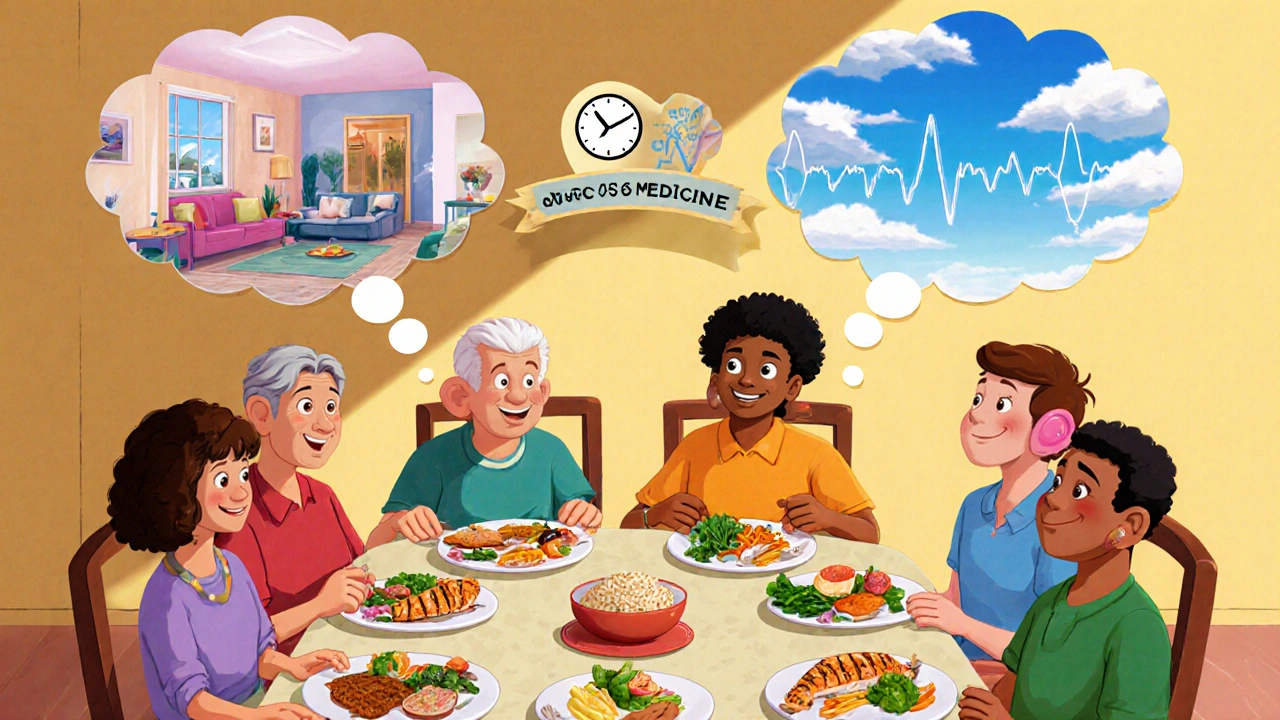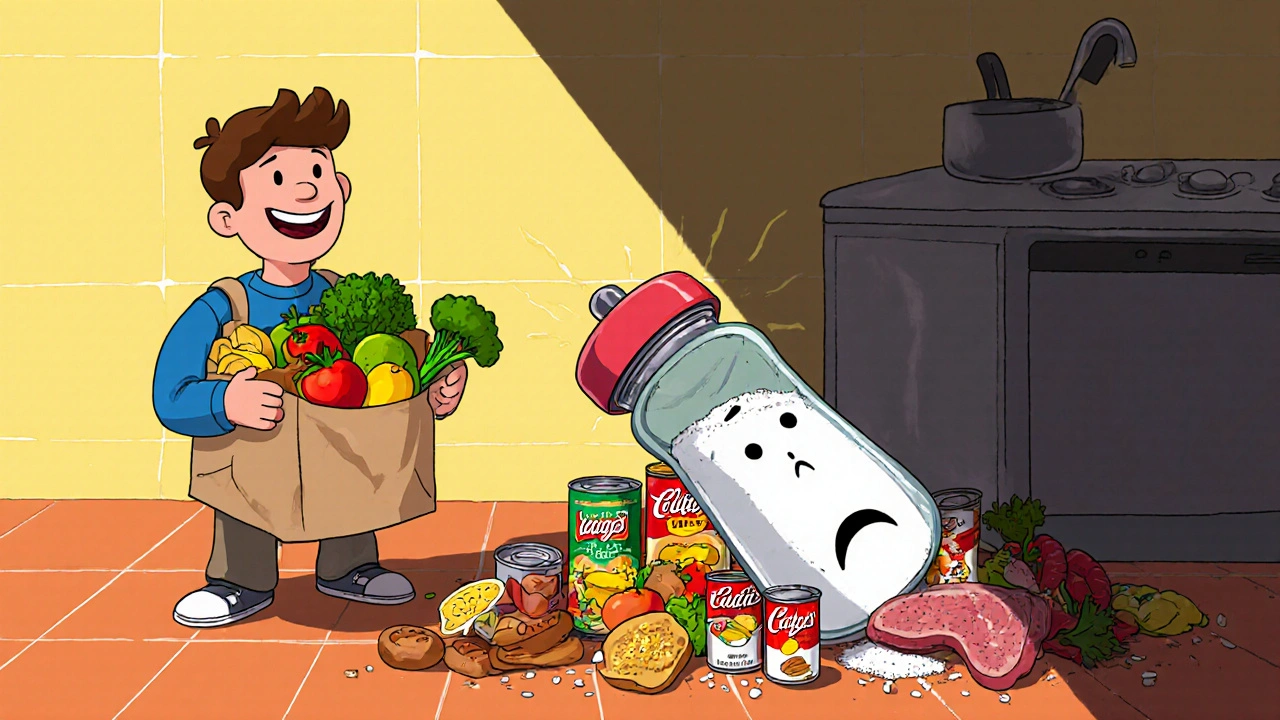When your world spins without warning, and your ear feels plugged up with pressure, it’s not just dizziness-it’s Meniere’s disease. For people living with this condition, the attacks can come out of nowhere: ringing in the ear, muffled hearing, nausea, and that terrifying sensation that the floor is tilting. While medications and injections are options, the most effective, safest, and most widely recommended first step is simple: change what you eat.
Why Salt Is the Enemy in Meniere’s Disease
Meniere’s isn’t caused by an infection or a tumor. It’s a fluid problem inside your inner ear. Too much fluid-called endolymph-builds up, creating pressure that damages delicate hair cells responsible for hearing and balance. This buildup is called endolymphatic hydrops. And what causes that excess fluid? Often, it’s sodium. Sodium pulls water into your bloodstream. When you eat too much salt, your body holds onto more fluid than it should. That extra fluid doesn’t just swell your ankles-it travels to your inner ear, worsening the pressure that triggers vertigo, hearing loss, and tinnitus. That’s why doctors have been telling Meniere’s patients to cut back on salt since the 1920s. Today, every major medical group agrees: a low-sodium diet isn’t just helpful-it’s essential. The American Academy of Otolaryngology, the Mayo Clinic, the NIH, and the British Ménière’s Society all list sodium restriction as the first line of treatment. Why? Because it works. And because it has almost no side effects.The Magic Number: 1,500 to 2,000 mg of Sodium Per Day
So how much salt is too much? The sweet spot for Meniere’s patients is between 1,500 and 2,000 milligrams of sodium per day. That’s about three-quarters of a teaspoon of table salt. Sounds low? It is. But here’s the thing: you’re not just avoiding the salt shaker. You’re fighting a hidden war. Seventy-seven percent of the sodium most people consume comes from processed and restaurant food-not from what you add at the table. A single slice of bread can have 230 mg. A cup of canned soup? 800 mg. A fast food burger? Over 1,000 mg before you even add ketchup. A 2024 study in Acta Otolaryngologica tracked 50 people with moderate to severe Meniere’s who stuck to a 1,500 mg/day sodium limit and drank 35 ml of water per kilogram of body weight daily. After six months, their hearing improved by an average of 12.3 decibels at key frequencies. Vertigo attacks dropped by over 50%. Tinnitus got noticeably quieter. Dizziness scores fell nearly in half. That’s not luck. That’s science.Hydration Isn’t What You Think
You’ve probably heard, “Drink more water.” But with Meniere’s, it’s not about guzzling gallons. It’s about balance. Drinking too little can make your body hold onto fluid like a sponge. Drinking too much can overload your system. The goal is steady, even hydration. The 2024 study used 35 ml per kilogram of body weight. For a 70 kg (154 lb) person, that’s about 2.5 liters a day-spread out over meals and snacks. Don’t chug water right before bed. Don’t wait until you’re thirsty. Sip throughout the day. Keep a water bottle handy. Avoid sugary drinks, energy drinks, and alcohol-they all disrupt fluid balance and can trigger attacks.
What to Eat (and What to Avoid)
You don’t have to eat bland food. You just have to be smart.- Choose fresh: Fruits, vegetables, lean meats, poultry, fish, beans, rice, and oats are naturally low in sodium.
- Read labels: Look for “no salt added,” “low sodium,” or “unsalted.” Anything over 400 mg per serving is too high.
- Shop the perimeter: The outer edges of the grocery store have fresh produce, meat, and dairy. The middle aisles are loaded with processed junk.
- Flavor with herbs: Use garlic, lemon, black pepper, cumin, paprika, rosemary, or chili flakes instead of salt. Salt-free seasoning blends work great.
Top Foods to Avoid
- Processed meats: bacon, ham, salami, hot dogs, deli slices
- Canned soups, vegetables, and beans (unless labeled low-sodium)
- Soy sauce, Worcestershire sauce, ketchup, mustard, relish
- Fast food: burgers, fries, pizza, tacos
- Pre-packaged meals: frozen dinners, ramen, mac and cheese
- Snack foods: chips, pretzels, crackers, salted nuts
- Bread and rolls (even whole grain-check the label)
Why Diuretics Are a Second Choice
Many doctors prescribe diuretics-water pills like hydrochlorothiazide-to flush out excess fluid. They help about half to 70% of patients. But they come with risks: low potassium, dizziness, kidney stones, and dehydration. Dietary sodium restriction doesn’t just avoid these side effects-it often works better. One study found that 68% of patients on a strict low-sodium diet saw major improvement, with no adverse effects. That’s higher than the success rate for many medications. And here’s the kicker: it costs almost nothing. No prescriptions. No co-pays. Just smarter grocery shopping.Real Challenges-And How to Beat Them
This isn’t easy. You’ll face pushback. Family says, “Just a little salt won’t hurt.” Restaurants serve food drenched in it. You miss the taste of your favorite snacks. A 2018 study found that 22% of Meniere’s patients gave up on the diet because it felt too hard. But those who stuck with it saw results. Here’s how to stay on track:- Keep a food journal. Write down everything you eat and drink. You’ll be shocked by hidden sodium.
- Call ahead when dining out. Ask for no salt, no sauce, and grilled instead of fried.
- Make extra meals on weekends. Freeze portions so you’re never stuck with a high-sodium option.
- Use apps like MyFitnessPal to track sodium. Set a daily limit of 1,800 mg to give yourself a buffer.
- Be patient. It can take 4 to 8 weeks to notice a difference. Don’t quit before you see results.

What About Other Triggers?
Sodium and fluid are the main drivers-but other things can make attacks worse.- Caffeine: Coffee, tea, energy drinks, and chocolate can constrict blood vessels in the inner ear. Limit to one cup a day, if any.
- Alcohol: Even small amounts can trigger vertigo. Avoid entirely if possible.
- Stress: High stress raises cortisol, which affects fluid balance. Try walking, breathing exercises, or yoga.
- Sugar spikes: High blood sugar can worsen inner ear inflammation. Avoid sugary cereals, sodas, and desserts.
What If It Doesn’t Work?
If you’ve been strict for 3-6 months and still have frequent attacks, you’re not failing. Meniere’s is complex. The next steps might include:- Intratympanic steroid injections (dexamethasone): injected into the middle ear, these reduce inflammation with minimal risk.
- Gentamicin injections: these destroy part of the balance nerve to stop vertigo-but they carry a risk of hearing loss.
- Surgery: only considered in severe, uncontrolled cases.
The Bigger Picture
There’s still debate. Some researchers think low salt works by boosting a hormone called aldosterone, which helps regulate inner ear fluid. Others believe it’s simply about reducing overall fluid load. The exact mechanism isn’t fully understood. But the outcome? Clear. People who eat low-sodium, stay hydrated, and avoid triggers have fewer attacks, better hearing, and less ringing in their ears. The largest ongoing study-the NIH-funded Meniere’s Dietary Intervention Trial-is currently tracking 300 people comparing 1,500 mg vs. 2,300 mg of sodium over a year. Results are due in late 2025. But even now, the evidence is strong enough to change lives. You don’t need a miracle cure. You need consistency. You need to treat your diet like medicine-because it is.Can I ever have salt again if my symptoms improve?
Some people can slowly increase sodium intake after months of stability, but most find that even small increases trigger symptoms. Think of it like managing high blood pressure-once you’re on a healthy plan, going back to old habits usually brings the problem back. If you do try adding salt, do it slowly and track your symptoms carefully.
Is sea salt or Himalayan salt better than table salt?
No. All salt is sodium chloride. Whether it’s white table salt, pink Himalayan, or coarse sea salt, the sodium content is nearly identical. The trace minerals in fancy salts don’t reduce the sodium or help Meniere’s. Stick to low-sodium options regardless of the type.
How long does it take to see results from a low-sodium diet?
Most people notice less dizziness and more stable hearing within 4 to 8 weeks. Full benefits-like fewer attacks and quieter tinnitus-often take 3 to 6 months. Don’t give up too soon. Your inner ear is healing slowly, like a bruise under the skin.
Can I drink alcohol on a Meniere’s diet?
Alcohol is a known trigger for many Meniere’s patients. It affects blood flow to the inner ear and can disrupt fluid balance. Even one drink can cause an attack the next day. Most experts recommend avoiding it entirely. If you choose to drink, limit it to a tiny amount and monitor your symptoms closely.
Do I need to take supplements on a low-sodium diet?
Generally, no. A low-sodium diet rich in whole foods provides all the nutrients you need. If you’re on a diuretic, your doctor may recommend potassium or magnesium supplements. But if you’re only changing your diet, focus on eating plenty of bananas, spinach, sweet potatoes, and beans-they’re naturally high in potassium, which helps balance sodium.
Is this diet safe for people without Meniere’s?
Yes. A diet under 2,000 mg of sodium per day is recommended by the American Heart Association for everyone to reduce blood pressure and heart disease risk. So even if you don’t have Meniere’s, eating this way benefits your overall health. It’s not a restrictive diet-it’s a healthier way to eat.

